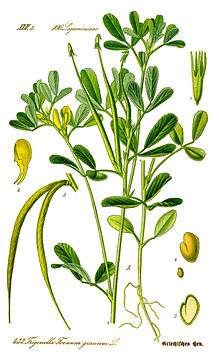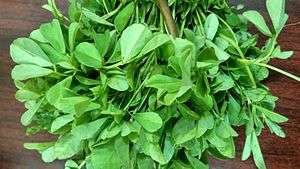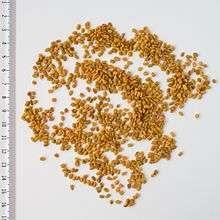Fenugreek
| Fenugreek | |
|---|---|
 | |
| Scientific classification | |
| Kingdom: | Plantae |
| Clade: | Angiosperms |
| Clade: | Eudicots |
| Clade: | Rosids |
| Order: | Fabales |
| Family: | Fabaceae |
| Genus: | Trigonella |
| Species: | T. foenum-graecum |
| Binomial name | |
| Trigonella foenum-graecum | |

Fenugreek (/ˈfɛnjʊɡriːk/; Trigonella foenum-graecum) is an annual plant in the family Fabaceae, with leaves consisting of three small obovate to oblong leaflets. It is cultivated worldwide as a semiarid crop. Its seeds and its leaves are common ingredients in dishes from South and Central Asia.
History
Fenugreek is believed to have been brought into cultivation in the Near East. While Zohary and Hopf are uncertain which wild strain of the genus Trigonella gave rise to domesticated fenugreek, charred fenugreek seeds have been recovered from Tell Halal, Iraq (carbon dated to 4000 BC), and Bronze Age levels of Lachish and desiccated seeds from the tomb of Tutankhamen.[2] Cato the Elder lists fenugreek with clover and vetch as crops grown to feed cattle.[3]
In one first-century A.D. recipe, the Romans flavoured wine with fenugreek.[4] In the 1st century AD, in Galilee, it was grown as a food staple, as Josephus mentions it in his book, the Wars of the Jews.[5]
Etymology
The English name derives via Middle French fenugrec from Latin faenugraecum, faenum Graecum meaning "Greek hay".[6]
Production
India is a major producer, with fenugreek production in India derived from numerous states. Rajasthan accounts for over 80% of India's output.[7]
Uses

Fenugreek is used as a herb (dried or fresh leaves), spice (seeds), and vegetable (fresh leaves, sprouts, and microgreens). Sotolon is the chemical responsible for fenugreek's distinctive sharp smell.
Cuboid-shaped, yellow- to amber-coloured fenugreek seeds are frequently encountered in the cuisines of the Indian subcontinent, used both whole and powdered in the preparation of pickles, vegetable dishes, dal, and spice mixes such as panch phoron and sambar powder. They are often roasted to reduce bitterness and enhance flavour.[8]
Cooking
Fresh fenugreek leaves are an ingredient in some curries, such as with potatoes in cuisines of the Indian subcontinent to make "aloo methi" ("potato fenugreek") curry.[9] Sprouted seeds and fenugreek greens are used in salads. When harvested as greens, fenugreek is known as samudra methi in Maharashtra, especially in and around Mumbai, where it is often grown in sandy tracts near the sea, hence the name samudra, "ocean" in Sanskrit. Samudra methi is also grown in dry river beds in the Gangetic plains. When sold as a vegetable, the young plants are harvested with their roots still attached and sold in small bundles in the markets and bazaars. Any remaining soil is washed off to extend their shelf life.
In Turkish cuisine, fenugreek seeds are used for making a paste known as çemen. Cumin, black pepper, and other spices are added into it, especially to make pastırma. In Persian cuisine, fenugreek leaves are called shanbalile. They are the key ingredient and one of several greens incorporated into ghormeh sabzi and eshkeneh as common Iranian dishes.
In Egyptian cuisine, peasants in Upper Egypt add fenugreek seeds and maize to their pita bread to produce aish merahrah, a staple of their diet. Fenugreek is used in Eritrean and Ethiopian cuisine.[10] The word for fenugreek in Amharic is abesh (or abish), and the seed is used in Ethiopia as a natural herbal medicine in the treatment of diabetes.[10]
Yemenite Jews following the interpretation of Rabbi Shelomo Yitzchak (Rashi) believe fenugreek, which they call hilbeh, hilba, helba, or halba "חילבה", to be the Talmudic rubia "רוביא". When the seed kernels are ground and mixed with water they greatly expand; hot spices, turmeric and lemon juice are added to produce a frothy relish eaten with a sop. The relish is also called hilbeh;[11] it is reminiscent of curry. It is eaten daily and ceremonially during the meal of the first and/or second night of the Jewish New Year, Rosh Hashana.[12]
Nutritional profile
| Nutritional value per 100 g (3.5 oz) | |
|---|---|
| Energy | 1,352 kJ (323 kcal) |
|
58 g | |
| Dietary fiber | 25 g |
|
6.4 g | |
|
23 g | |
| Vitamins | Quantity %DV† |
| Thiamine (B1) |
28% 0.322 mg |
| Riboflavin (B2) |
31% 0.366 mg |
| Niacin (B3) |
11% 1.64 mg |
| Vitamin B6 |
46% 0.6 mg |
| Folate (B9) |
14% 57 μg |
| Vitamin C |
4% 3 mg |
| Minerals | Quantity %DV† |
| Calcium |
18% 176 mg |
| Iron |
262% 34 mg |
| Magnesium |
54% 191 mg |
| Manganese |
59% 1.23 mg |
| Phosphorus |
42% 296 mg |
| Potassium |
16% 770 mg |
| Sodium |
4% 67 mg |
| Zinc |
26% 2.5 mg |
| Other constituents | Quantity |
| Water | 8.8 g |
|
| |
| |
|
†Percentages are roughly approximated using US recommendations for adults. Source: USDA Nutrient Database | |
In a 100 g amount, fenugreek seeds provide 1,350 kilojoules (323 kcal) of food energy and contain 9% water, 58% carbohydrates, 23% protein and 6% fat, with calcium at 40% of the Daily Value (DV, table). Fenugreek seeds (per 100 g) are a rich source of protein (46% DV), dietary fiber, B vitamins, and dietary minerals, particularly manganese (59% DV) and iron (262% DV) (table).
Safety
Fenugreek sprouts, cultivated from a single specific batch of seeds imported from Egypt into Germany in 2009, were implicated as the source of the 2011 outbreak of Escherichia coli O104:H4 in Germany and France.[13] Identification of a common producer and a single batch of fenugreek seeds supports the epidemiologic evidence implicating them as the source of the outbreaks.[14]
Some people are allergic to fenugreek, and people who have peanut allergies or chickpea allergies may also have a reaction to fenugreek.[15] Fenugreek seeds can cause diarrhea, dyspepsia, abdominal distention, flatulence, perspiration, and a maple-like smell to urine or breast milk.[15][16] There is a risk of hypoglycemia particularly in people with diabetes; it may also interfere with the activity of anti-diabetic drugs.[15] Because of the high content of coumarin-like compounds in fenugreek, it may interfere with the activity and dosing of anticoagulants and antiplatelet drugs.[15] Fenugreek may affect uterine contractions and may be unsafe for women with hormone-sensitive cancers.[16]
It causes birth defects in animals and there are reports that it also causes birth defects in humans, and that it can pass through the placenta; it also appears to negatively affect male fertility, female fertility, and the viability of embryos in animals and humans.[15]
Traditional medicine
In traditional medicine, fenugreek is thought to promote digestion, induce labour, and reduce blood sugar levels in diabetics, although the evidence for these effects is lacking.[16]
In herbalism, fenugreek is thought to increase breast milk supply in nursing mothers.[17] This is not supported by good medical evidence and fenugreek intake is not recommended for this purpose.[18]
Animal feed
Fenugreek is sometimes used as animal feed. It provides a green fodder palatable to ruminants. The seeds are also used to feed fish, domestic rabbits and ruminants. [19]
Research
Constituents of fenugreek seeds include flavonoids, alkaloids, coumarins, vitamins, and saponins; the most prevalent alkaloid is trigonelline and coumarins include cinnamic acid and scopoletin.[15]
A 2016 meta-analysis combining the results of 12 small studies, of which only three were high quality, found that fenugreek may reduce some biomarkers in people with diabetes and with pre-diabetic conditions, but that better quality research would be required in order to draw conclusions.[20] As of 2016, there was no high-quality evidence for whether fenugreek is safe and effective to relieve dysmenorrhea.[21]
References
- ↑ "Trigonella foenum-graecum". Germplasm Resources Information Network (GRIN). Agricultural Research Service (ARS), United States Department of Agriculture (USDA). Retrieved 2008-03-13.
- ↑ Zohary, Daniel; Hopf, Maria; Weiss, Ehud (2012). Domestication of Plants in the Old World: The Origin and Spread of Domesticated Plants in Southwest Asia, Europe, and the Mediterranean Basin (4th ed.). Oxford University Press. p. 122.
- ↑ Cato the Elder. De Agri Cultura. p. 27.
- ↑ Curry A (February 2010). "A 9,000-Year Love Affair". National Geographic. 231 (2): 46.
- ↑ Josephus, De Bello Judaico, book 3, chapter 7, vs. 29. The prepared relish made from ground fenugreek seeds is very slimy and slippery, and was therefore poured over ladders as a stratagem to prevent the enemy's ascent.
- ↑ "Online Etymology Dictionary". www.etymonline.com. Retrieved 2017-02-07.
- ↑ V. A. Parthasarathy, K. Kandinnan and V. Srinivasan (ed.). "Fenugreek". Organic Spices. New India Publishing Agencies. p. 694.
- ↑ "BBC - Food - Fenugreek recipes". Retrieved 2017-02-07.
- ↑ "14 dishes to eat if you're a vegan in Karachi". Images. 29 March 2018. Retrieved 7 July 2018.
- 1 2 Gall, Alevtina; Zerihun Shenkute (November 3, 2009). "Ethiopian Traditional and Herbal Medications and their Interactions with Conventional Drugs". EthnoMed. University of Washington. Retrieved January 27, 2011.
- ↑ "Hilba (Fenugreek paste) Cooking with chillies recipe". Cookipedia.co.uk. Retrieved 2017-02-07.
- ↑ This is based on the assumption that the Aramaic name רוביא corresponds to it. (Karetot 6a; Horiyot 12a) Rabbenu Nissim at the end of Rosh Hashana, citing the custom of R Hai Gaon. This follows Rashi's translation of רוביא, cited as authoritative by Tur and Shulchan Aruch OC 583:1. But Abudirham interprets רוביא as black-eyed peas.
- ↑ McKenna, Maryn (2011-07-07). "E. coli: A Risk for 3 More Years From Who Knows Where". Wired.
- ↑ King, L. A.; Nogareda, F.; Weill, F.-X.; Mariani-Kurkdjian, P.; Loukiadis, E.; Gault, G.; Jourdan-DaSilva, N.; Bingen, E.; Mace, M.; Thevenot, D.; Ong, N.; Castor, C.; Noel, H.; Van Cauteren, D.; Charron, M.; Vaillant, V.; Aldabe, B.; Goulet, V.; Delmas, G.; Couturier, E.; Le Strat, Y.; Combe, C.; Delmas, Y.; Terrier, F.; Vendrely, B.; Rolland, P.; de Valk, H. (2012). "Outbreak of Shiga Toxin-Producing Escherichia coli O104:H4 Associated With Organic Fenugreek Sprouts, France, June 2011". Clinical Infectious Diseases. 54 (11): 1588–1594. doi:10.1093/cid/cis255. ISSN 1058-4838.
- 1 2 3 4 5 6 Ouzir, M; El Bairi, K; Amzazi, S (2016). "Toxicological properties of fenugreek (Trigonella foenum graecum)". Food and Chemical Toxicology. 96: 145–54. doi:10.1016/j.fct.2016.08.003. PMID 27498339.
- 1 2 3 "Fenugreek". National Center for Complementary and Integrative Health. September 2016. Retrieved 6 February 2017.
- ↑ Bazzano AN, Hofer R, Thibeau S, Gillispie V, Jacobs M, Theall KP (2016). "A Review of Herbal and Pharmaceutical Galactagogues for Breast-Feeding". Ochsner J. 16 (4): 511–524. PMC 5158159. PMID 27999511.
- ↑ Mortel M, Mehta SD (2013). "Systematic review of the efficacy of herbal galactogogues". J Hum Lact (Systematic review). 29 (2): 154–62. doi:10.1177/0890334413477243. PMID 23468043.
- ↑ Heuzé V., Thiollet H., Tran G., Lebas F., 2018. Fenugreek (Trigonella foenum-graecum). Feedipedia, a programme by INRA, CIRAD, AFZ and FAO. https://www.feedipedia.org/node/242
- ↑ Gong, J; Fang, K; Dong, H; Wang, D; Hu, M; Lu, F (2 August 2016). "Effect of Fenugreek on Hyperglycaemia and Hyperlipidemia in Diabetes and Prediabetes: a Meta-analysis". Journal of Ethnopharmacology. 194: 260–268. doi:10.1016/j.jep.2016.08.003. PMID 27496582.
- ↑ Pattanittum, Porjai; Kunyanone, Naowarat; Brown, Julie; Sangkomkamhang, Ussanee S; Barnes, Joanne; Seyfoddin, Vahid; Marjoribanks, Jane (2016). "Dietary supplements for dysmenorrhoea". Cochrane Database of Systematic Reviews. 3: CD002124. doi:10.1002/14651858.CD002124.pub2. PMID 27000311.
| Look up fenugreek in Wiktionary, the free dictionary. |